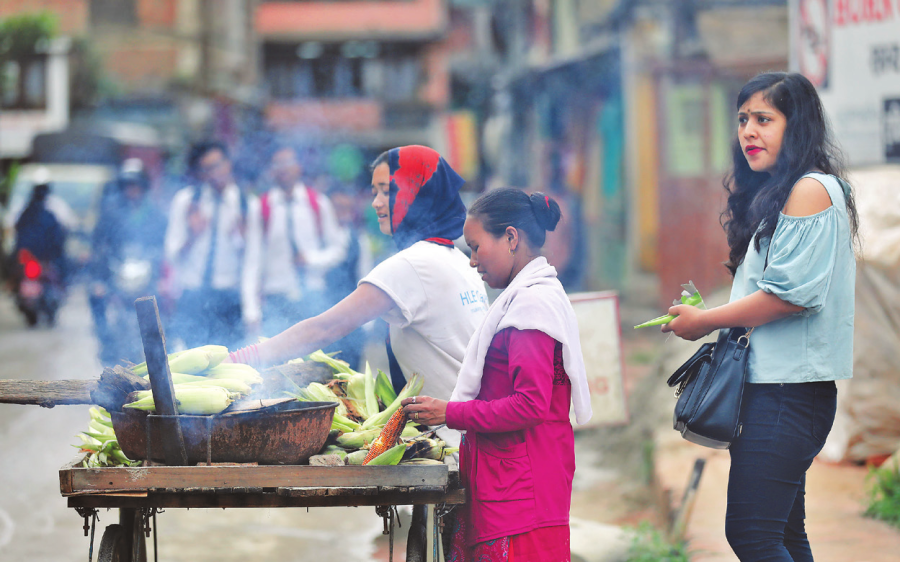Columns
Street smart business
A well thought-out regulatory mechanism for street vendors is the need of the hour.
Roshee Lamichhane
News about the harassment of street vendors in Kathmandu by city authorities has been doing the rounds for more than a year now. On the one hand, they are being ill-treated; and on the other, their goods are being confiscated. As a result of such ad hoc trials and tribulations, the lives of around 34,000 street vendors have been threatened or affected in one way or another. Before this situation deteriorates, the government and Kathmandu Metropolitan City should enact and institute legal means while also analysing the alternatives for the best possible way out.
Street businesses are typical globally, including India, Thailand, Vietnam, Mexico, and Taiwan. They are also the lifeblood of some economies as they have gained widespread popularity and operate in many forms and formats, such as street food vendors (dedicated roadside eateries or mobile food vendors), street performers, night markets and street retailers. These sectors contribute to the informal economy while reflecting local culture and tradition.
Street food vendors in Thailand have earned an international reputation for their street-side delicacies. In addition, local markets such as Chatuchak market and different kinds of flower and floating markets are the major attractions for both locals and foreigners in Thailand. Such street-side businesses and dedicated markets contribute to keeping the cities alive. Hanoi and Ho Chi Minh City in Vietnam are other popular destinations for street-side business, especially the vibrant street food scene. Places like Chandni Chowk in Delhi and Colaba Causeway in Mumbai, to name a few, are famous for street-side businesses of all kinds. Moreover, countries like Mexico, Taiwan and Singapore are renowned for street life. They are equally known for incorporating pragmatic policies and effective regulations for managing street vendors.
Regulation of vendors
While formulating a regulatory policy is one thing, implementing and enforcing it is a critical issue altogether, posing a real challenge to the administrators. Though the Street Vendor Protection Act 2014 was widely lauded for enabling legislation to ensure effective representation of street vendors in India, its below-par implementation leaves much to be desired. One of the reasons why implementation has remained a formidable challenge is because identity cards and vending certificates have not been issued to all vendors. Likewise, town vending committees, responsible for identifying the street vendors, issuing vending certificates and maintaining records of the vendors, are yet to be established in many places. What’s more, implementation becomes increasingly complicated when the measures to protect street vendors contradict urban planning measures. Urban planners usually tend to visualise hawker-free or non-vending zones when planning intelligent cities, neglecting the survival of the lifeline of the street and infringing on their rights. Such contradictions, if any, must be resolved to make a liveable city that promises sustainable policies for street vendors.
While the above challenges persist, opportunities exist if we want a change. Chandigarh ranks first among union territories in India to exercise the Street Vendor Act cautiously and has generated Rs210 million in vendor fees since October 2017. In Thailand, unplanned efforts to curb or ban street businesses without proper homework have been met with resistance and demonstrations by vendors. Protests were made when authorities tried to bulldoze, raze structures and clear the streets without providing an alternative to those affected. Instances of suicide were also observed when vendors were evicted without options. Bangkok plans to restore sidewalks for pedestrians by pledging to assist affected vendors through affordable relocations and sustainable contracts for their operations.
Bangkok, which ideally offers both high- and low-ticket tourism, is worthy of emulation for a city like Kathmandu. Bangkok’s night market is juxtaposed with iconic high-rise buildings and hotels. This signifies the peaceful coexistence of haves and have-nots, representing all strata of society without whose presence even the most happening city can’t survive. Kathmandu Valley with its distinct cultural heritage should offer residents from various income levels the opportunity to live together harmoniously. As the city thrives in the natural hustle and bustle, lack of vendors in places such as market squares and areas of historical significance erodes the place's natural beauty. Thus, instead of forcing out street vendors, our authorities must immediately develop legal mechanisms and enforcement measures to ensure the safety and survival of the dwellers.
Designated space
For instance, the legal mechanism should allow vendors to restart their business in a designated alternative space before evacuating them to clear the way for pedestrians and ensure wider roads and pavements. The government should collect a street vendor tax. Banning street vendors hurts the sentiments of the people at the grassroots, making them feel helpless and excluded. So, at this juncture, the solution does not lie in depriving businesses or evicting business personnel but in creating intelligent and effective regulation. Now, balancing the economic needs of the street vendors and keeping in place a well thought-out regulatory mechanism is the need of the hour. This should begin with designated street markets for food vendors, other street vendors and retailers. They should also receive necessary training and resources to improve hygiene and safety practices.
If implemented cautiously, street-side business continues to ably support the marginalised communities by representing and promoting local cuisine, art and culture. It can not only create vibrancy by exhibiting local arts and culture but also remain a good source of domestic and international tourism.




 9.12°C Kathmandu
9.12°C Kathmandu.jpg)















